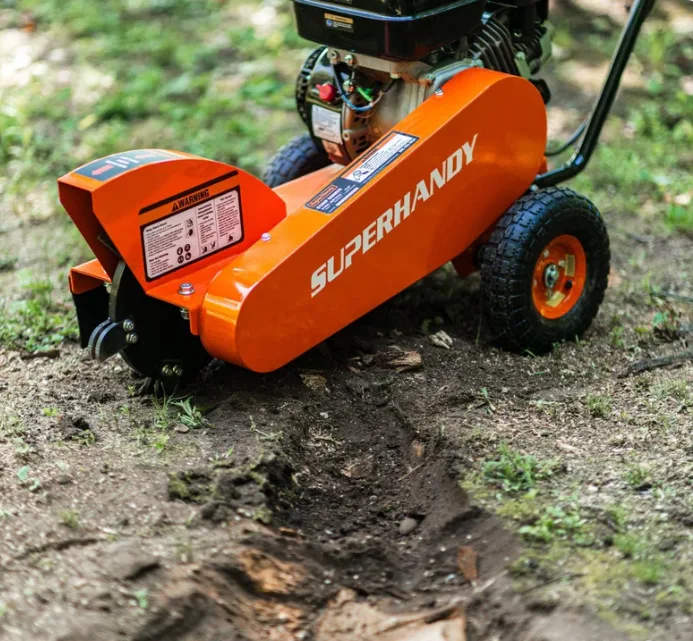Effective Strategies for Stump Grinding and Removal
A fallen tree leaves behind more than just memories; it leaves a persistent, stubborn, and often unsightly stump. While some homeowners view the remaining wood as a natural feature, others recognize it as a safety hazard and an impediment to landscaping dreams. The solution lies in choosing the right removal strategy. Stump grinding, a mechanical process that systematically eliminates the stump below the surface, stands out as the most efficient and environmentally responsible method. This guide delves into the mechanics of grinding, the best practices for assessing your stump, key seasonal considerations, and the essential tools and techniques required to master the art of stump grinding and removal, whether you choose to tackle it yourself or hire a professional.
The Science Behind Stump Grinding: Understanding the Process
How Stump Grinding Works: A Peek Into the Mechanics
Stump grinding is a precision technique focused on mechanically dismantling the tree’s remnants several inches below ground level. This process relies on a dedicated machine known as a stump grinder.
The core mechanism involves a powerful engine, typically gas or electric, that rotates a heavy steel wheel fitted with dozens of sharp, tungsten-carbide teeth. These teeth are designed to chisel, slice, and pulverize the tough wood fibers. The operator positions the grinding wheel over the stump and, using hydraulic controls, systematically lowers the wheel while moving it laterally in a sweeping motion across the stump’s surface.
The operation is two-fold: the high-speed rotation chips away the stump layer by layer, eventually grinding the entire mass into small, manageable wood shavings. This method is far cleaner than traditional digging, which involves significant excavation and leaves a large hole filled with uprooted soil and debris. Grinding converts the stump into a heap of nutrient-rich mulch, which naturally fills the resulting cavity, allowing the area to be reclaimed quickly for new grass or landscaping. Understanding this mechanism highlights the efficiency and minimal soil disruption that grinding offers over aggressive physical removal.
The Environmental Impact of Grinding Versus Removal
When deciding between stump grinding and complete stump removal (extraction), the environmental differences are significant. Complete removal necessitates excavating the entire root ball, which severely disrupts the surrounding soil structure, microbial ecosystems, and established plant life. This aggressive digging can lead to significant erosion, habitat disturbance, and long recovery times for the affected area.
In contrast, stump grinding minimizes ecological disruption. By grinding the visible stump and crown several inches below grade, the extensive, stabilizing lateral roots are left largely intact. These residual roots remain in place to help anchor the soil, preventing erosion while gradually decomposing and naturally enriching the soil structure over many years. The wood chips produced from grinding act as a natural mulch, further feeding the soil as they break down. Furthermore, removing the above-ground, decaying wood reduces the likelihood of attracting destructive pests like termites or carpenter ants, which might otherwise seek shelter in the residual matter. From an ecological standpoint, grinding is a proactive conservation measure that facilitates a rapid, healthy return to the natural balance of your yard.
Choosing the Right Equipment: A Guide to Tools and Machinery
Selecting the appropriate equipment is essential for a safe and effective operation. For DIY enthusiasts, renting a stump grinder from a local equipment supplier is the typical route, but the choice of machine must be based on the specific job.
The primary factors determining equipment choice are:
- Stump Size and Wood Type:Large, dense hardwood stumps (like oak or maple) require high-horsepower, commercial-grade machines. Smaller, softer stumps (like pine) can usually be managed with portable, tow-behind models ranging from 10 to 20 horsepower.
- Depth of Grind:Deeper root systems necessitate grinders with a greater capacity for vertical travel below grade.
Before grinding, a chainsaw is often used to cut the stump as close to the ground as possible, saving significant grinding time. Critically, safety equipment is non-negotiable: industrial-strength goggles, ear protection, a durable helmet, and steel-toed boots are mandatory, as the grinder generates high noise levels and dangerous flying debris. Familiarity with the operational and safety guidelines of the specific machine is the best insurance against accidents.
When to Grind or Remove a Stump: Timing Is Everything
Identifying Stumps: The Types and Their Challenges
Not all stumps present the same challenge, and their characteristics, species, size, and age, must inform the removal plan.
- Hardwood Stumps (Oak, Maple, Hickory):These are dense and tough, requiring higher horsepower and patience during grinding. Their robust root systems are often more resistant to decomposition.
- Softwood Stumps (Pine, Spruce, Willow):These are typically easier and faster to grind due to their lighter, less dense composition.
- Age:Older stumps are often softer and partially rotted, making grinding quicker. Younger, healthy stumps from recently felled trees are still vigorous and present a tougher obstacle.
A large stump with an aggressive, wide-spreading root system will necessitate more extensive grinding and potentially follow-up work to prevent future regrowth. A thorough assessment of the stump’s type and condition is the first step toward a successful outcome.
Seasonal Considerations: Optimal Times for Grinding
While stump grinding can generally be performed year-round, certain seasons offer optimal conditions that boost efficiency and ease.
- Late Winter/Early Spring:This period is often ideal because the ground is firmer, providing a stable base for the heavy grinding equipment and improving machine maneuverability. Furthermore, many adjacent plants are dormant, minimizing the risk of accidental damage to sensitive vegetation.
- Summer:Grinding in the warmer months allows for immediate replanting or landscaping efforts, taking advantage of the growing season. This is particularly efficient if the new landscape design depends on the stump’s complete removal.
It is wise to avoid periods of heavy precipitation. Wet, muddy conditions make operating heavy equipment difficult, potentially churning the landscape and reducing the grinder’s effectiveness. Conversely, extremely dry, compacted soil can also strain the machine. Monitoring local weather patterns allows homeowners to schedule their operation during periods that promise stable, firm working conditions.
Signs It’s Time to Say Goodbye: Assessing Health and Safety Risks
A lingering tree stump should be removed when it begins to pose health, safety, or aesthetic risks to the property:
- Pest and Disease Risk:Decaying stumps are prime targets for pests like termites, carpenter ants, and beetles, which can migrate from the dead wood to attack healthy trees and even the structure of your home. They can also harbor fungal diseases that spread through the soil.
- Safety Hazard:Stumps, especially those partially hidden by grass, are tripping hazards for people and obstacles for lawnmowers, leading to potential accidents or equipment damage.
- Aesthetic and Landscaping Interference:An unsightly stump detracts from the property’s overall appearance and prevents essential landscaping projects, such as building a patio, installing a fence, or planting new trees.
- Regrowth Potential:Stumps from certain aggressive species will often sprout new shoots (suckers), forcing continuous manual upkeep.
Proactive removal, particularly grinding, mitigates these risks, ensuring a safe, functional, and visually appealing outdoor space.
Mastering the Art of Root Removal: Techniques and Tips
The Roots Beneath: Understanding Their Growth Patterns
The success of removal hinges on understanding what lies beneath the surface. Tree roots spread in diverse patterns; most trees feature a network of shallow, wide-spreading lateral roots, with only some species having a prominent, deep taproot. For most trees, the root network can extend for many feet beyond the trunk, although the thick, dense roots near the stump are the most problematic.
While the grinder easily handles the visible stump, the thick roots just below the soil are often left intact, leading to potential regrowth or soil settling problems. Before grinding, it is helpful to use a shovel or soil auger to expose the immediate roots surrounding the stump. Understanding that different species have different root characteristics (e.g., willow roots break easily; oak roots are tough) allows for better preparatory work and informs the extent of grinding needs to prevent future sprouting.
Effective Techniques for Complete Root Extraction
The goal of complete root extraction is to eliminate enough of the residual root structure to prevent regrowth and ensure the stability of the soil. A multi-step approach is most effective:
- Deep Grinding:Grind the main stump mass down to a depth of 8 to 12 inches below the soil surface. This depth is typically sufficient to prevent most species from resprouting.
- Manual Excavation:Use hand tools like a pickaxe, mattock, or heavy-duty spade to break up the compacted soil and manually remove the larger, exposed root sections surrounding the former stump area.
- Chemical Acceleration:For roots too large or deep to physically remove, some homeowners opt for a chemical accelerant, such as a potassium nitrate mixture, applied to the exposed root surface. This process hastens natural decay but requires patience, as it can take weeks or months to see significant results.
Proper removal ensures that the area is truly clear, avoiding the long-term nuisance of constant sprouting.
Post-Removal Care: Preparing Your Ground for the Future
Once grinding is complete, effective post-removal care is essential for preparing the area for new use.
First, the large cavity left by the stump must be properly filled. The wood chips generated by the grinding process are ideal for filling the bulk of the hole, as they settle naturally and decompose over time, enriching the soil. However, the top few inches should be filled with high-quality topsoil to maintain aesthetic appeal, prevent water pooling, and create a fertile base for new grass or planting.
Second, the soil should be assessed for nutrient balance. Amending the area with compost or nutrient-rich fertilizer will encourage healthy growth. Finally, regular monitoring is necessary for the first few months to ensure no dormant roots attempt to sprout new growth. This post-removal care transforms a former hazard into a blank slate for future landscaping endeavors.
DIY Stump Grinding: Pros, Cons, and Practicalities
The Appeal of Going Solo: Benefits of DIY Approaches
For many homeowners, undertaking stump grinding as a DIY project is an appealing proposition driven by both practical and personal motivations.
The foremost benefit is cost savings, as the expense of renting equipment often falls below the cost of professional service, especially for a single, small-to-medium stump. DIY also offers complete control over the process, allowing the homeowner to dictate the exact timing, the depth of the grind, and the specific cleanup methods used. Furthermore, engaging in hands-on landscaping work fosters a sense of accomplishment and allows homeowners to gain valuable knowledge about their property’s unique root systems and soil structure.
Common Pitfalls: Mistakes to Avoid When Going It Alone
Despite the benefits, DIY stump grinding is not without serious risks. The machines are powerful and can cause severe injury if mishandled.
Common mistakes to avoid include:
- Underestimating the Equipment:Failing to respect the machine’s power or neglecting to read the operational and safety manuals can lead to immediate danger.
- Inadequate Site Preparation:Not thoroughly clearing the work area of rocks, debris, and utility lines before grinding can cause dangerous kickbacks, flying projectiles, and property damage.
- Ignoring Follow-up:Failing to remove or treat all residual roots can lead to future regrowth, frustrating the effort.
DIY efforts require extensive safety preparation and a realistic assessment of the physical labor involved, particularly the cleanup phase.
When to Call the Pros: Knowing Your Limitations
While DIY is tempting, there are definitive circumstances when hiring a professional service is the safest and most economical choice. One of the leading factors is the size and complexity of your project. Stumps that are too large, too embedded in the ground, or interconnected with other tree roots often require the expertise of seasoned professionals who possess the right equipment and experience to handle the task efficiently. For projects that demand precise stump grinding and removal, especially near infrastructure or with large, aggressive root systems, professional expertise is generally the best choice.
Additionally, if complications arise, such as ground-level utilities, proximity to infrastructure, or safety hazards from surrounding plants or trees, reaching out to specialists is paramount. Professionals understand these complexities and bring the experience needed to address them without causing undue damage to the property. Ultimately, recognizing one’s limitations ensures a smoother process, allowing for a well-managed and successfully executed project.
Final Conclusion
Stump grinding is an efficient, environmentally sound solution that transforms a landscape liability into an opportunity for renewal. By leveraging the right tools, respecting safety guidelines, and making informed decisions about whether to DIY or hire a professional, homeowners can successfully navigate the process and reclaim their outdoor space for future use.







